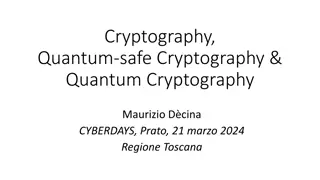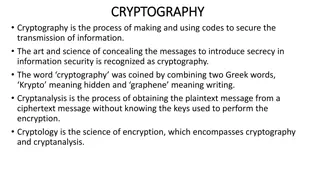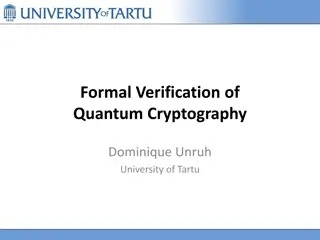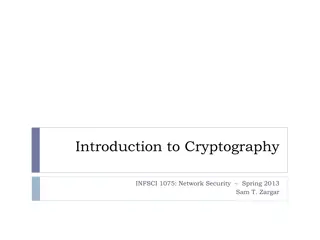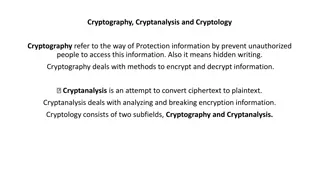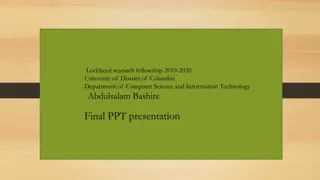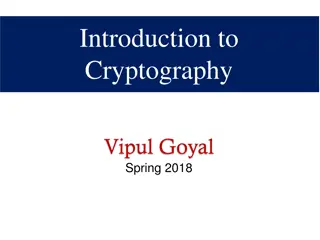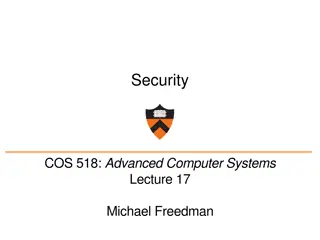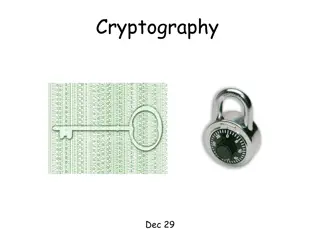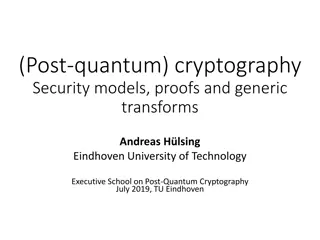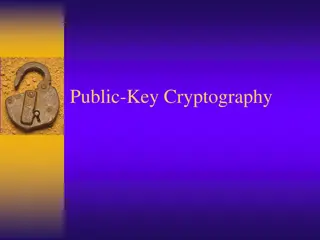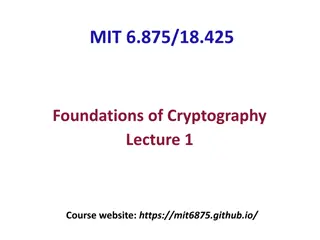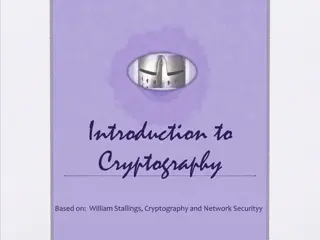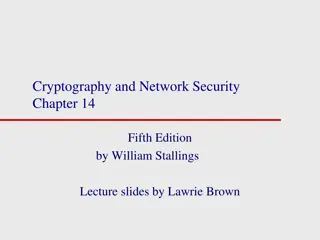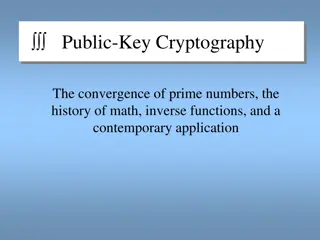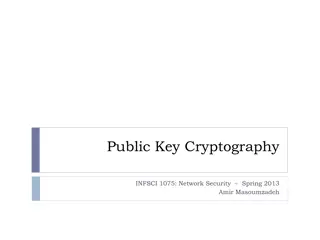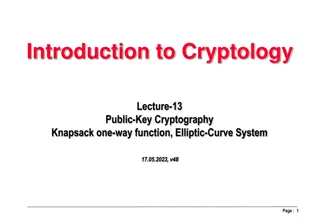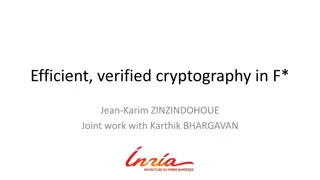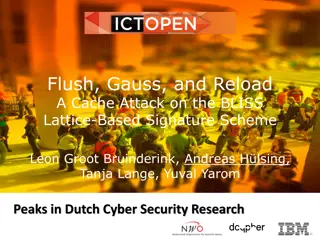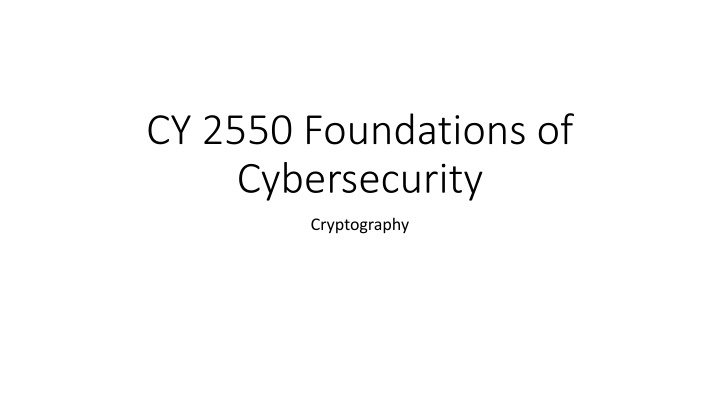
Essentials of Cryptography and Cybersecurity: Exploring Key Concepts
Delve into the foundations of cybersecurity cryptography, understanding the science of secrets, essential terminology, fundamental goals of information security, additional modern crypto goals, cryptographic protocols, attacker threat models, and key concepts regarding encryption and decryption. Explore the significance of cryptanalysis, cryptology, and the importance of secure communication protocols in overcoming adversaries and ensuring data confidentiality, integrity, and authenticity.
Download Presentation

Please find below an Image/Link to download the presentation.
The content on the website is provided AS IS for your information and personal use only. It may not be sold, licensed, or shared on other websites without obtaining consent from the author. If you encounter any issues during the download, it is possible that the publisher has removed the file from their server.
You are allowed to download the files provided on this website for personal or commercial use, subject to the condition that they are used lawfully. All files are the property of their respective owners.
The content on the website is provided AS IS for your information and personal use only. It may not be sold, licensed, or shared on other websites without obtaining consent from the author.
E N D
Presentation Transcript
CY 2550 Foundations of Cybersecurity Cryptography
The Science of Secrets Cryptography: the study of mathematical techniques to providing aspects of information security services Creating secrets Cryptanalysis: the study of mathematical techniques for attempting to defeat information security services Breaking secrets Cryptology: the study of cryptography and cryptanalysis
Terminology Plaintext Ciphertext Plaintext Encryption Decryption Encryption_Key Decryption_Key
Fundamental Goals Confidentiality no eavesdropping Integrity no unauthorized modifications Authenticity no spoofing or faking Non-repudiation no disclaiming of authorship
Additional Goals of Modern Crypto Pseudo-random number generation Anonymity E-voting Secret sharing Zero-knowledge proof Secure multi-party computation Computation over encrypted data (homomorphic encryption)
Cryptographic Protocols Protocols that Enable parties to Achieve goals to Overcome adversaries Need to understand Who are the parties and the context in which they act? What are the security goals of the protocols? What are the capabilities of the adversaries?
Attacker Threat Model 1. Interaction with messages and the protocol Passive: only observes and attempts to decrypt messages Only threatens confidentiality Active: observes, modifies, or deletes messages Threatens confidentiality, integrity, and authenticity 2. Full knowledge of the chosen cryptographic algorithm Kerchhoff s Principle A cryptosystem should be secure even if everything about the system, except the key, is public knowledge Shannon s Maxim The enemy knows the system No security through obscurity
Attacker Threat Model 3. Interaction with cipher algorithm Chosen-plaintext attack Attacker may choose a number of messages and obtain the ciphertexts for them Chosen-ciphertext attack Attacker may choose a number of ciphertexts and obtain the plaintexts Both attacks may be adaptive Choices may change based on results of previous requests 4. Computationally bounded Finite resources to calculate and store things No quantum computers
Cryptography and Cryptanalysis through history
Approaches to Secure Communication Steganography covered writing hides the existence of a message depends on secrecy of method Cryptography hidden writing hide the meaning of a message depends on secrecy of a short key, not method
Caesar Shift Simple symmetric substitution cipher Key is a number k To encrypt, shift each letter by k positions To decrypt, shift each letter back by k positions HEY BRUTUS BRING A KNIFE TO THE PARTY K = 3 KHB EUXWXV EULQJ D NQLIH WR WKH SDUWB
Cryptanalysis of Shift Cipher Brute force: try all 25 possible keys (assuming English text) K = 0 and K = 26don t make sense Lessons? Simple, exhaustive key search can be effective Key space needs to be large enough to prevent attack
Monoalphabetic Substitution Cipher Replace each letter X with (X) where is a permutation In this cipher, the key is the permutation Key space is all possible permutations For English: 26! = 4*1026 HELLO WORLD A B C D E F G H I J K L M N O P Q R S T U V W X Y Z = C A D O Z H W Y G B Q X L V T R N M S K J I P F E U YZXXT PTMXO
Cryptanalysis of Monoalphabetic Substitution Dominates cryptography through the first millennium Exhaustive search is infeasible (26! = 4*1026 possible keys) Frequency analysis Remember Al-Kindi from 800 AD?
Frequency Analysis Human languages have patterns Frequency of letter usage Frequency of n-letter combinations These patterns survive substitution = B A D C Z H W Y G O Q X L V T R N M S K J I P F E U
Cryptanalysis of Monoalphabetic Substitution Dominates cryptography through the first millennium Exhaustive search is infeasible (26! = 4*1026 possible keys) Frequency analysis Remember Al-Kindi from 800 AD? Lessons? Use large blocks: instead of replacing ~6 bits at a time, replace 64 or 128 bits Leads to block ciphers like DES and AES Use different substitutions to prevent frequency analysis Leads to polyalphabetic substitution ciphers and stream ciphers
Vigenre Cipher (1596) Main weakness of monoalphabetic substitution ciphers: Each letter in the ciphertext corresponds to only one letter in the plaintext Polyalphabetic substitution cipher Given a key K = (k1, k2, , km) Shift each letter p in the plaintext by ki, where i is modulo m A B C D E F G H I J K L M N O P Q R S T U V W X Y Z 0 1 2 3 4 5 6 7 8 9 10 11 12 13 14 15 16 17 18 19 20 21 22 23 24 25 Plaintext CRYPTOGRAPHY Key (Shift 11 20 2 10 11 20 2 11 ) LUCK LUCKLUCK Ciphertext NLAZEIIBLJJI
Cryptanalysis of Vigenre Cipher Essentially a collection of shift ciphers One letter in ciphertext corresponds to multiple letters in plaintext Frustrates, but doesn t stop frequency analysis Cracking Vigen re (1854 or 1863) 1. Guess the key length x using Kasisky test or index of coincidence 2. Divide the ciphertext into x shift cipher encryptions 3. Use frequency analysis on each shift cipher
Kasisky Test Plaintext T H E S U N A N D T H E M A N I N T H E M O O N Key K I N G K I N G K I N G K I N G K I N G K I N G Ciphertext D P R Y E V N T N B U K W I A O X B U K W W B T Distance = 8 Repeating patterns (of length >2) in ciphertext are a tell Likely due to repeated plaintext encrypted under repeated key characters The distance is likely to be a multiple of the key length
Cryptanalysis of Vigenre Cipher Cracking Vigen re (1854 or 1863) 1. Guess the key length x using Kasisky test of index of coincidence 2. Divide the ciphertext into x shift cipher encryptions 3. Use frequency analysis on each shift cipher Lessons? As key length increases, letter frequency becomes more random If key never repeated, Vigen re wouldn t be breakable
One Time Pads and Perfect Secrecy
One Time Pad (1920s) Fix the vulnerability of the Vigen re cipher by using very long keys Key is a random string that is at least as long as the plaintext Similar encryption as with Vigen re (different shift per letter)
Cryptanalysis of OTP Intuitively, the key is random, so ciphertext is also random OTP achieves Perfect Secrecy Shannon or Information Theoretic Security Basic idea: ciphertext reveals no information about plaintext An encryption over message space M is perfectly secure iff probability distribution over M message m M ciphertext c C for which P(c) > 0 we have P(PT=m | CT=c) = P(PT=m) Where PT is plaintext and CT is ciphertext
In English The adversary believes the probability that the plaintext is m is P(PT=m)before seeing the ciphertext Maybe they are very sure, or maybe they have no idea The adversary believes the probability that the plaintext is m is P(PT=m | CT=c) after seeing that the ciphertext is c P(PT=m | CT=c) = P(PT= m) means that after knowing that the ciphertext is c, the adversary s belief does not change Intuitively, the adversary learned nothing from the ciphertext
Put Another Way Imagine you have a ciphertext c where the length |c| = 1000 I can give you a key ki with |ki| = 1000 such that: The decrypted message mi is the first 1000 characters of Hamlet Or, I can give you a key kj with |kj| = 1000 such that: The decrypted message mj is the first 1000 characters of the US Constitution If an algorithm offers perfect secrecy then: For a given ciphertext of length n All possible corresponding plaintexts of length n are possible decryptions
Cryptanalysis of OTP Intuitively, the key is random, so ciphertext is also random OTP achieves Perfect Secrecy Shannon or Information Theoretic Security Basic idea: ciphertext reveals no information about plaintext Caveats If the length of the OTP key is less than the length of the message It s not a OTP anymore, not perfectly secret! If you reuse the OTP key It s not a OTP anymore, not perfectly secret! Major issue with OTP in practice? How to securely distribute the key books to both parties
Modern Symmetric Block Cyphers
Symmetric Key Cryptography Algorithms that use a single key for encryption and decryption i.e. the algorithm is reversible k m Dk(Ek(m)) = m where m is a message, k is a key, and Dk and Ek are decryption and encryption using k Historic examples: Caeser shift, mono and polyalphabetic substitution, OTP Modern examples: DES, 3DES, RC4, Blowfish, Twofish, AES Warning: many of these methods are known to be vulnerable
Why Block Ciphers? One way to defeat frequency analysis Use different keys in different locations Examples: OTP, stream ciphers Another way Make the unit of transformation larger Instead of encrypting letter by letter (~6 bits), encrypt block by block (n bits)
Data Encryption Standard (DES) Designed by IBM, with modifications proposed by the NSA US national standard from 1977 to 2001 Block size is 64 bits Key size is 56 bits Has 16 rounds Designed mostly for fast implementation in hardware Software implementation is somewhat slow Considered insecure now Vulnerable to brute-force attacks, key too short
Advanced Encryption Standard (AES) In 1997, NIST made a formal call for algorithms stipulating that the AES would specify an unclassified, publicly disclosed encryption algorithm, available royalty-free, worldwide Goal: replace DES for both government and private-sector encryption. The algorithm must implement symmetric key cryptography as a block cipher and (at a minimum) support block sizes of 128-bits and key sizes of 128-, 192-, and 256-bits. In 1998, NIST selected 15 AES candidate algorithms. In 2000, NIST selected Rijndael (invented by Joan Daemen and Vincent Rijmen) as the AES
AES Features Designed to be efficient in both hardware and software Block size: 128 bits Variable key size: 128, 192, or 256 bits No known weaknesses
AES Example Eavesdropper Alice Bob KAES KAES M EKAES(M) EKAES(M) M
Need for Encryption Modes A block cipher encrypts only one block But a message may be longer than one block Need a way to extend the algorithm to encrypt arbitrarily long messages Need to ensure that if block cipher is secure, then whole encryption is secure Unit test vs. integration test Whole operation should be IND-CPA secure if block cipher is IND-CPA secure
Electronic Code Book (ECB) Mode Message is broken into independent blocks Each block is encrypted separately Plaintext 1 Plaintext 2 Plaintext n Block Cipher Encryption Block Cipher Encryption Block Cipher Encryption Key Key Key Ciphertext 1 Ciphertext 2 Ciphertext n
Cryptanalysis of ECB Mode Deterministic The same data block always gets encrypted the same way Reveals patterns when data repeats! m encrypted with k always produces the same c This is the same problem we had with the Vigen re cipher Do not use ECB mode in practice
Cipher Block Chaining (CBC) Mode Uses a random Initialization Vector (IV) Block i depends on block i-1 is exclusive bitwise OR (XOR) Plaintext 1 Plaintext 2 Plaintext n IV Block Cipher Encryption Block Cipher Encryption Block Cipher Encryption K K K Ciphertext 0 Ciphertext 1 Ciphertext 2 Ciphertext n
Cryptanalysis of CBC Mode CBC randomizes the encryption IV ensures initial block is randomized Dependency between blocks propagates randomness Usage in practice: choose random IV and protect its integrity The IV is not secret (it becomes part of the ciphertext) Do not let the adversary control the IV CBC is IND-CPA assuming Block cipher itself is secure IV is truly random IV is sufficiently large
Review of Computational Complexity
Towards Computational Security Perfect secrecy is too difficult to achieve in practice Imagine trying to do OTP encryption with every website that uses HTTPS Computational security uses two relaxations: 1. Security is preserved only against computationally bounded adversaries Limits on computational power and storage No quantum computers 2. Adversaries may successfully crack encryption with a very small probability So small that (we hope) it becomes negligible
Crash Course in Computational Complexity O(1) (define (add2 num) (+ 2 num)) Constant Time Assuming a list of length n O(n) Linear Time (define (sum lon) (cond [(empty? lon) 0] [(cons? lon) (+ (first lon1) (sum (rest lon)))]))
Crash Course in Computational Complexity Two lists of length n O(n2) Quadratic Time (define (make-list-of-sums lon1 lon2) (cond [(empty? lon1) ()] [(cons? lon1) (append (helper (first lon1) lon2) (make-list-of-sums (rest lon1) lon2))])) (define (helper num lon2) (cond [(empty? lon2) ()] [(cons? lon2) (cons (+ num (first lon2)) (helper num (rest lon2)))]))
Crash Course in Computational Complexity O(n log n) Quicksort O(2n) Exponential Time (define (fibonacci n) (if (<= n 1) n (+ (fibonacci (- n 2)) (fibonacci (- n 1)))))
Applications to Cryptography O(1) < O( ?) < O(n) < O(n log n) < O(n2) < O(n3) < < O(2n) < O(n!) < When we desire computational security, we want algorithms where: Verifying a given solution can be done in polynomial time or faster Computing a novel solution takes O(2|k|) time or worse This is what we mean by a computationally bound adversary Given infinite computers, a O(2|k|) time problem can be solved
Towards Computational Security Perfect secrecy is too difficult to achieve in practice Imagine trying to do OTP encryption with every website that uses HTTPS Computational security uses two relaxations: 1. Security is preserved only against computationally bounded adversaries Limits on computational power and storage No quantum computers 2. Adversaries may successfully crack encryption with a very small probability So small that (we hope) it becomes negligible
Ciphertext Indistinguishability under a Chosen-Plaintext Attack (IND-CPA) k, Ek Round 1: choose k and encryption algo m0 , m1 M Round 2: choose two plaintext messages b R {0, 1} Round 3: choose a random binary number c = Ek(mb) Round 4: encrypt the corresponding message b' {0, 1} Round 5: guess the value of b Adversary wins if b = b
Analyzing the IND-CPA Game If E is a perfectly secure algorithm, what is the probability that b = b ? P(Mallory wins) = k, Ek m0 , m1 M If E is a Caesar shift, what is the probability that b = b ? b R {0, 1} c = Ek(mb) b' {0, 1} P(Mallory wins) = 1 Adversary wins if b = b
Analyzing the IND-CPA Game If E is computationally secure algorithm, what is the probability that b = b ? P(Mallory wins) = + negligible(|k|) k, Ek m0 , m1 M b R {0, 1} c = Ek(mb) b' {0, 1} Adversary wins if b = b

